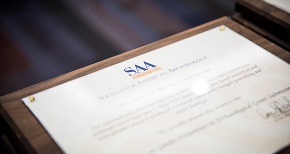Please be aware when registering, all times are in the Eastern Time Zone. Even for free events, you will need to click the "Proceed to Checkout" button and "Submit Order"
to complete your registration. If you do not receive an automated confirmation email, or if you have any questions about registration, please email
onlineseminars@saa.org.
![Quantification in Zooarchaeology: Calculating and Critiquing NISP, MNI, and MNE [Deeper Digs]](/images/default-source/opengraph/onlineseminars/faunal_overlay.tmb-seminar.png?Culture=en&sfvrsn=b2c5d242_1)
Registration Closed!
Quantification in Zooarchaeology: Calculating and Critiquing NISP, MNI, and MNE [Deeper Digs]
When: February 24, 2023 1:00-3:00 PM ET
Duration: 2 hours
Certification: RPA-certified
Pricing
Individual Registration: $99 for SAA members; $149 for non-members
Group Registration: $139 for SAA members; $189 for non-members
Gillian Wong, PhD, RPA, University of Tuebingen and Metropolitan Community College - Kansas City
Dr. Wong received a PhD in Archaeological Sciences from the University of Tuebingen (Germany), a MS in Anthropology from the University of Utah, and a BA in Anthropology from the University of California, Davis. She is currently a postdoctoral researcher at the University of Tuebingen and an adjunct professor of anthropology at Metropolitan Community College - Kansas City. She is a zooarchaeologist who is particularly interested in how large-scale environmental changes affected past foragers on the local-level. She is currently involved in two research projects, one at Langmahdhalde, a Paleolithic site in southwest Germany, and one at Boomplaas Cave in South Africa. Although both projects focus on paleoecology, she uses different methods at each. At Langmahdhalde, she now focuses on traditional zooarchaeological methods and stable isotopes, while at Boomplaas Cave, she is a microfaunal specialist.
Dr. Wong received a PhD in Archaeological Sciences from the University of Tuebingen (Germany), a MS in Anthropology from the University of Utah, and a BA in Anthropology from the University of California, Davis. She is currently a postdoctoral researcher at the University of Tuebingen and an adjunct professor of anthropology at Metropolitan Community College - Kansas City. She is a zooarchaeologist who is particularly interested in how large-scale environmental changes affected past foragers on the local-level. She is currently involved in two research projects, one at Langmahdhalde, a Paleolithic site in southwest Germany, and one at Boomplaas Cave in South Africa. Although both projects focus on paleoecology, she uses different methods at each. At Langmahdhalde, she now focuses on traditional zooarchaeological methods and stable isotopes, while at Boomplaas Cave, she is a microfaunal specialist.
This course is designed for archaeologists at any stage in their career (including students and late career stage) who are not specialists in zooarchaeology or who do not work with the quantification units used regularly in zooarchaeology. We will focus on learning about three of the most commonly used quantification units: Number of Identified Specimens (NISP), Minimum Number of Elements (MNE), and Minimum Number of Individuals (MNI). We will learn how to calculate these units and the history of their development, but, more importantly, will also learn how to interpret them and evaluate their use and applicability to research questions. This course will be broken up into lecture, practical, and discussion portions that will give participants the tools to easily and more accurately interpret zooarchaeological studies that use these three units. Additionally, reference materials, lecture slides, and study examples will be provided to all participants.
- Explain how NISP, MNE, and MNI are calculated
- Describe the limitations of each of these quantification units
- Analyze when it is appropriate to apply each of these quantification units
- Be able to critically evaluate and understand these units in colleagues' research
- Be able to discuss how these units apply to and can address specific research questions


